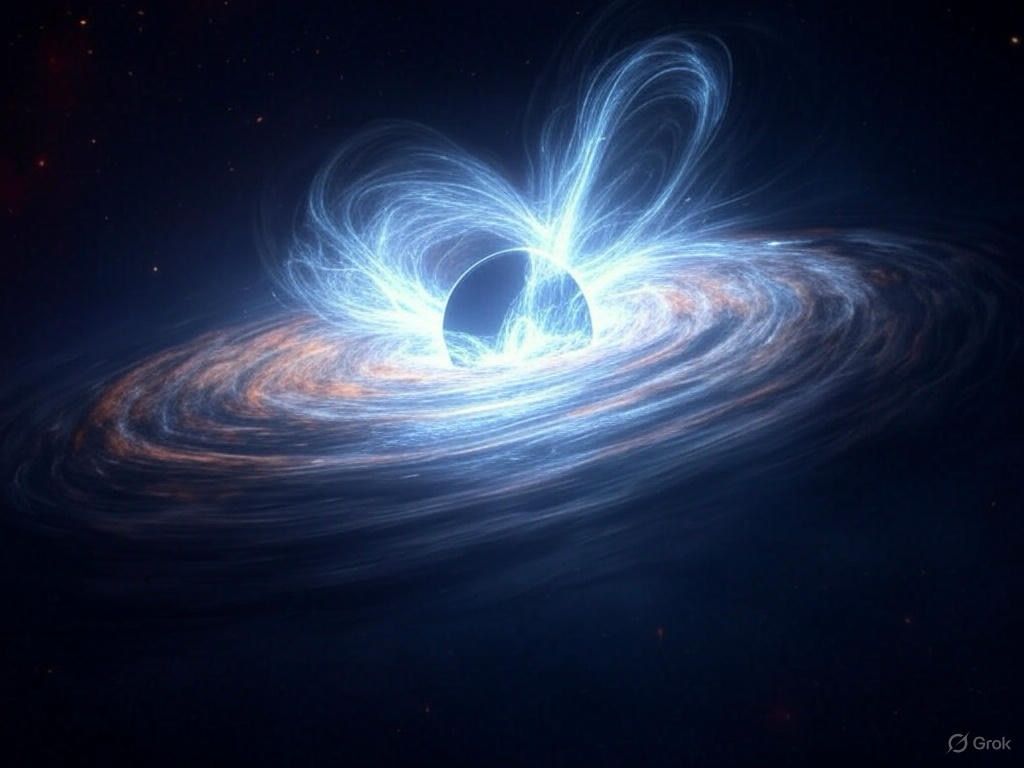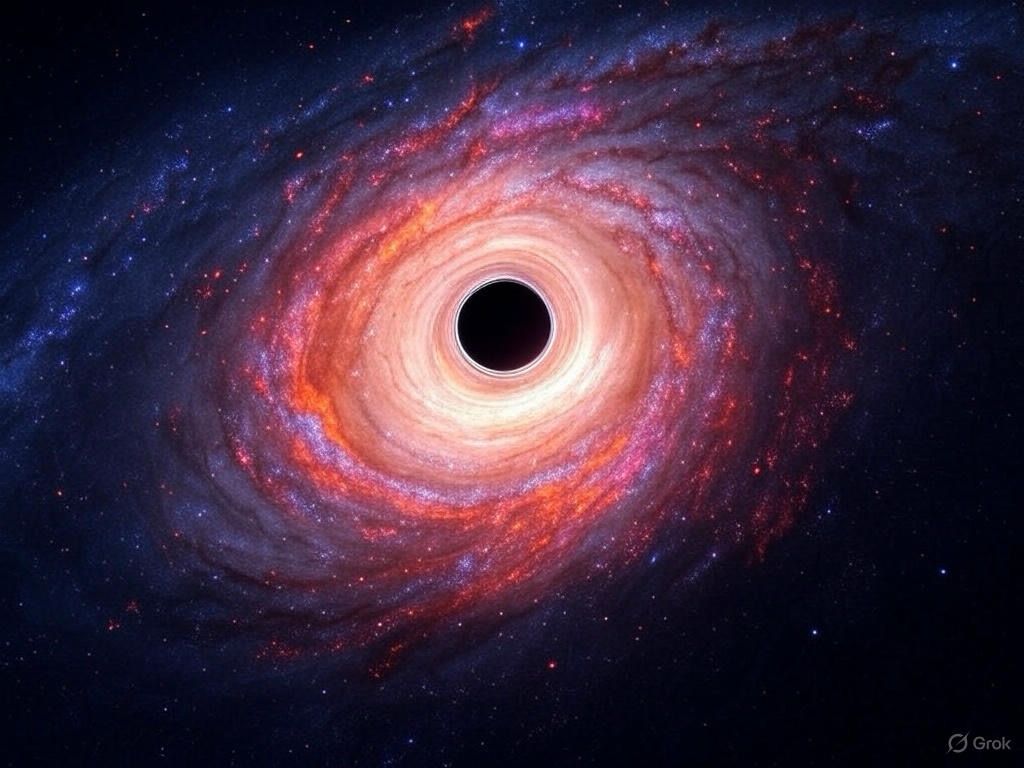Picture this: a supermassive black hole, chilling 300 million light-years away in a galaxy called SDSS1335+0728, suddenly decides it’s done napping. Since 2019, this cosmic beast—lovingly nicknamed Ansky—has been throwing a fit, blasting out bursts of light like a kid with a sparkler on steroids. Astronomers, who thought they had black holes figured out, are now huddled over their telescopes, muttering, “What is this guy doing?” Ansky’s wild behavior is rewriting the rules, and I’m here to break it down in a way that feels like we’re chatting over coffee—complete with a table to keep things tidy.
Waking Up with a Bang

You imagine yourself being Ansky a black hole which spent a prolonged slumber while drifting at the center of your galaxy keeping yourself occupied. The year 2019 marks the start of Ansky emitting light when the astronomer community noticed this event in real-time. You start releasing bright light as if you were performing an intergalactic firework stunt. Astronomers managed to observe this phenomenon because it provided them with a one-of-a-kind opportunity.
The international community of astronomers largely views this discovery as highly important according to leading astronomer Lorena Hernández-García from Chile. Ansky extended an invitation to everyone who wanted to observe this spectacular stellar growth stage. Our observations of black holes have never witnessed this kind of transformation where one changes from being bland to spectacular.
A black hole exists in complete darkness because it has no ability to shine on its own making it the peak camouflager among cosmic things. The approaching gases or dust normally spiral toward the black hole once they get too close and create strong heat which causes the strong sky lighting from infrared to X-rays. According to scientists Ansky glows due to its feeding behavior though scientists remain puzzled about its dining habits.
Ansky’s Light Show: Not Your Average Fireworks
Ansky isn’t just glowing—it’s throwing full-on tantrums. Its bursts of light, called quasi-periodic eruptions (QPEs), are longer, brighter, and weirder than anything astronomers have seen. Here’s how Ansky stacks up against a “normal” black hole outburst:
| What’s Happening? | Typical Black Hole Bursts | Ansky’s Wild Tantrums |
| How Long They Last | A few seconds to hours | Days—like, way longer |
| How Bright They Are | Decent, but not dazzling | 10 times brighter, a total show-off |
| Energy Released | Enough to notice | 100 times more, like a cosmic power surge |
| Timing Between Bursts | Random or quick | Every 4.5 days, like clockwork |
| Light Colors | Mostly X-rays | Everything—X-rays, infrared, you name it |
“Ansky’s outbursts are on another level,” says Joheen Chakraborty, an astrophysicist at MIT. “Each one’s like a supernova going off, and they keep coming every few days. It’s like the black hole’s got a schedule and it’s sticking to it.”
Normally, scientists think these bursts happen when something small, like a star, gets too close and gets tangled in the black hole’s swirl of stuff, causing regular flares. But Ansky? It’s like it’s dancing to a tune we can’t hear.
Black Holes Aren’t Just Cosmic Vacuums
Let’s clear up a myth: black holes aren’t giant Roombas sucking up everything in sight. They’ve got limits. Their gravity only grabs what’s close enough, so they can spend ages just chilling, barely eating. The black hole in our Milky Way, for example, is super quiet, like it’s on a diet. Ansky was like that too—until it wasn’t.
When black holes do get active, they’re like chefs cooking up a storm. They gobble up gas, dust, or even stars, and that frenzy shapes their galaxies. It’s not just about getting bigger; their energy blasts can spark new stars or shuffle the galaxy’s chemistry. So, Ansky’s outburst isn’t just cool—it’s a clue to how galaxies grow up.
Why Ansky’s Got Everyone Confused
Scientists thought they had a handle on these outbursts. The usual guess? A star or something gets caught in the black hole’s orbit, like a toy in a whirlpool, causing flares every time it swings by. But Ansky’s throwing curveballs:
- It’s Crazy Bright: The light’s so intense, it’s like Ansky’s showing off across every wavelength. A single star couldn’t do that.
- The Bursts Drag On: These aren’t quick flashes—they linger for days, like Ansky’s savoring every bite.
- Perfect Timing: Every 4.5 days, boom, another burst. It’s so regular, it’s spooky.
- All the Colors: From infrared to X-rays, Ansky’s lighting up the whole spectrum, hinting at something big and messy going on.
“It’s like Ansky’s laughing at our theories,” says Erwan Quintin from the European Space Agency. “We thought we knew the dance, but this black hole’s got new moves.”
Could Ansky Be Making Waves?
Here’s where it gets wilder: Ansky’s outbursts might be sending ripples through space itself—gravitational waves, the kind you get when massive things like black holes orbit or smash together. If Ansky’s got a buddy, like another black hole, their cosmic waltz could be causing these bursts and waves.
There’s a mission called LISA, launching in the 2030s, that’s built to catch these ripples. “If we can match Ansky’s X-rays with gravitational waves, it’d be like hearing the universe sing,” Quintin says. That could tell us what’s got Ansky so worked up.
What’s Ansky Gonna Do Next?
The astronomers are glued to their screens, watching Ansky like it’s the season finale of their favorite show. They’re asking:
- What’s It Eating? Is it another black hole, a funky disk of gas, or something we’ve never seen?
- How Long’s This Party Lasting? Will Ansky keep raging or crash back to sleep?
- Can We Guess the Next Burst? That 4.5-day beat might help test new ideas.
They’re bringing in the big guns—telescopes, X-ray observatories, and maybe even LISA down the road—to crack the case. For now, Ansky’s keeping its secrets.
Why Ansky Feels Like a Friend (Sort Of)
Ansky’s not just a science puzzle—it’s like that quirky friend who surprises you every time you hang out. Each burst is a little nudge, saying, “Hey, the universe is weirder than you think.” Lorena Hernández-García puts it best: “Every flash from Ansky feels personal, like it’s daring us to figure it out.”
The full story’s in Nature Astronomy, and trust me, it’s worth keeping an eye on. Ansky’s got more surprises up its sleeve, and I’m betting it’ll keep us guessing for years.
Wanna dig deeper? Check out the study in Nature Astronomy.





